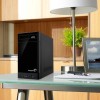Seagate STBN100 Seagate Business Storage 1-Bay, 2-Bay, and 4-Bay NAS User Guid - Page 25
NTP (Network Time Protocol) server, parity, private share, RAID, RAID 0, remote access, RSA key - disk manager
 |
View all Seagate STBN100 manuals
Add to My Manuals
Save this manual to your list of manuals |
Page 25 highlights
Glossary NTP (Network Time Protocol) server Synchronizes the date and time of computers and servers on a network, based on Coordinated Universal Time (UTC). parity Data created in volumes with RAID 5 protection that's used to reconstruct files if one of the disk drives in the server fails. See also RAID 5. private share A folder that is accessible only to users with permission granted by the share's owner. RAID Redundant Array of Independent Disks. A technology that combines disk drives together for improved performance and fault tolerance (the ability to withstand the failure of a disk drive). RAID 0 See stripe. RAID 1 See mirror. RAID 10 A level of RAID protection. A volume with RAID 10 is built from two or more equal-sized RAID 1 volumes. Data in a volume with RAID 10 is both striped and mirrored. Mirroring provides data protection, and striping improves performance. See also mirror, and stripe. RAID 5 A level of RAID protection. A volume with RAID 5 is built from a minimum of three disk drives, and uses data striping and parity data to provide redundancy. (Parity is extra information that's used to re-create data if a disk drive fails. In volumes with RAID 5, parity data is striped evenly across the disk drives with the stored data.) Parity data provides data protection, and striping improves performance. See also stripe. remote access Access to the server from a computer that is not on your local network. For instance, accessing the server from a client's computer, over the Internet, is remote access. Remote access can also refer to shutting down or resetting the server using Seagate NAS Manager instead of physically pressing the Power button. See also local access. RSA key An encryption decoder that's part of SSL, a type of encryption used to protect data being sent over a network or the Internet. "RSA" stands for Rivest, Shamir, and Adelman, who invented the technology. Seagate Business Storage NAS User Guide 25












